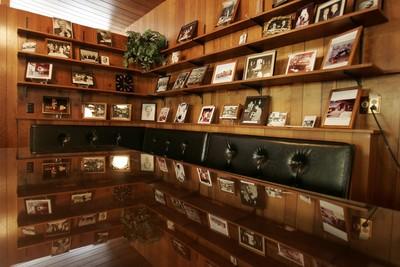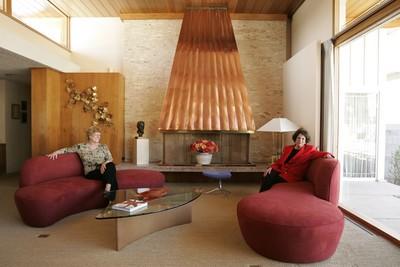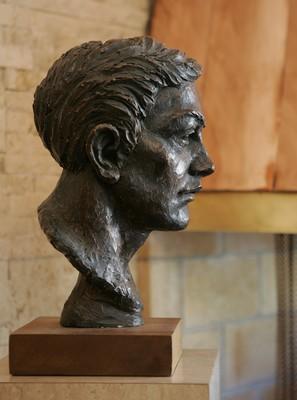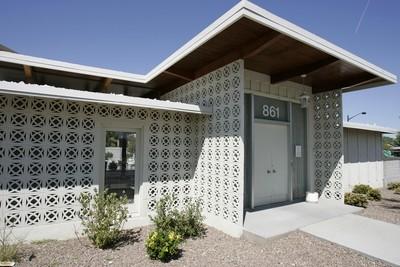A Slice of Cool
Close your eyes, let your imagination wander, and it's not difficult to picture Antonio Morelli and the guys -- Frank, Dino, anybody else who wanted to unwind after the show -- sprawled around the copper-topped fireplace in the living room before crowding into the kitchen's dining nook for an early morning bite.
Then, when you're finished doing that, open your eyes and allow yourself to revel in the retro, lounge era-steeped cool of Antonio and Helen Morelli's home.
Morelli was orchestra conductor and music director at the Sands during the '50s and '60s and lived in a home at the now-deceased Desert Inn Estates. Now, thanks to the Junior League of Las Vegas, everybody can catch a glimpse of how not only the Morellis, but Las Vegas' hip crowd in general, lived back then.
Since 2001, the league has purchased, moved and then restored the Morelli home, which now serves as the group's headquarters. On Monday, the Junior League was scheduled to officially open the restored Morelli house to the public.
For those with an interest in cool architecture, nostalgic baby boomers or students of Las Vegas' entertainment history, the house is nothing less than a time machine.
The home was built in 1959 at Desert Inn Estates. Back then, its rear windows looked out on the Desert Inn Golf Course's second hole, while the Morelli's pool was situated in the front yard. According to architecture historian and author Alan Hess, the home is a classic example of midcentury modern architecture.
Midcentury modern, born in the years following World War II, reflects the buoyant, optimistic mood of the time, Hess said. "There was the baby boom. There's prosperity. People are sitting down and starting their lives, starting their families, starting their businesses, and they had such a sense of optimism. The future was wide open.
"So people, especially in new cities like Las Vegas and Phoenix and Los Angeles, chose an architecture that was equally new, fresh, looking to the future. And that's basically what midcentury architecture is about."
A midcentury home "did not look like any traditional house," Hess said. "It did not look like a Tudor or an American colonial house. That was absolutely essential."
But it did look "like it was made by a machine," Hess continued, with sharp lines, flat roofs and concrete block ornamentation.
Another hallmark of the midcentury style is an open, airy interior layout.
In the Morelli home, "the living room and the entry are all open, all together in one big room," Hess said. "They flow together and, also, the view flows right outside through these huge glass (windows)." The fresh, clean newness of midcentury modern was its primary appeal back then. Today, that remains its primary appeal, particularly throughout parts of the West.
"It really provides an alternative in the housing market for people who are looking for something different. That's the main thing," Hess said. "But, then, it was originally good architecture and, sooner or later, good architecture will be rediscovered and re-recognized."
After Morelli's death, Helen Morelli moved back East and the home was purchased by a new owner who made no significant alterations to it. The home was slated for demolition when the Junior League purchased it, moved it to its current site at Ninth Street and Bridger Avenue in 2001 and then spent the past several years restoring it.
Janet R. White, an assistant professor of architecture at the University of Nevada, Las Vegas, said the Morelli house is significant for both its architecture and because of Morelli himself, who "was a major contributor to the culture of this town."
Sherry Colquitt, Morelli house project director for the Junior League, said the restoration was challenging. Fortunately, she added, "every time you were down and out and there was just no way this was going to work, someone has popped up and said, 'I'll do it.'
"That's the way it's gone. Every time we thought we were down for the count, somebody brought smelling salts around."
Hess said the Morelli house has "all of the basics of midcentury modern -- that open plan, a lot of the glass exposed, natural wood. The fireplace is quite grand in a modern way. It's stone and it's really a showpiece, a focal point."
But, he said, "the thing that kind of impressed me or really struck me about the Morelli house was how homey it was."
The couple had at least a considerable hand in designing the home, and Hess suspects Helen Morelli "had a lot to do with making it comfortable. It's not severe. It's not austere."
The home features touches that would be familiar to any baby boomer, as well as a few that would be considered unusually hip even today. For instance, what looks like a TV cabinet in the kitchen is actually a bar: Just swing the console away from the wall, flip up a shelf and mix up martinis with abandon.
And, the living room curtains open and close with a touch of a button. To the side of the bed in the master bedroom are switches that control lighting throughout the entire house.
Dedee Nave, Junior League assistant project director, notices that the Morellis "thought about storage like you wouldn't believe." Throughout the house are touches designed to maximize storage space via well-placed or hidden nooks or cubbyholes.
In the living room, a fireplace with a sweeping copper head swoops to the ceiling, while panes of horizontal glass situated between the top of interior walls and the ceiling take maximum advantage of sunlight and help to create a modernistic vibe, too.
Off of the master bedroom, two hallways offer closet space -- the slide-out drawers and tie rack weren't common back then -- and lead to the master bathroom, which features a dramatic sunken tiled shower and a separate raised sink for the tallish Morelli. The faucets are monogrammed, and on the bathroom mirror is the space-ageish clock the Morellis installed there.
The living and dining rooms feature serpentine sofas, a nimbus table, a barrel chair and other pieces designed and donated to the project by Vladimir Kagan, known, Colquitt said, as "the father of midcentury modern furniture."
Kagan came to Las Vegas last summer for a furniture show, Colquitt said. "We went down to talk to him, told him about the house, and said, 'Would you like to see it?'
"He walked in and said, 'Ladies, you have no idea what a jewel you have with this house. Will you allow me to be your lead designer? I will contact my manufacturer to donate furniture.' "
"That," Colquitt marvels, is "incredible."
About 35 community donors also have contributed to the restoration. Eventually, their names will be listed on a plaque at the front entrance made out of appropriately futuristic black Lucite.
Hess said he's "heartened" by the Junior League's efforts to save the Morelli house and hopes the project will help to "reawaken Las Vegas' awareness of its heritage, because there are other houses of this style out there all over the place."
"I don't think they're very well-known, but they are there," he added. "And once you shine a spotlight on the Morelli house, other people will say, 'I didn't know I lived in a midcentury modern house.' ''
Maybe even more importantly, Colquitt thinks the Morellis would approve.
Considering the care and attention they invested in their home, she said, "I know how happy they'd be to have someone else see it."
TOUR THE HOUSE
The Junior League of Las Vegas is accepting appointments for tours of the Morelli house at 861 Bridger Ave.
The tours will be conducted by Junior League volunteers and highlight the features of the home, its furnishings, and the life and times of Antonio Morelli.
People and groups may reserve tours as much as three months in advance by calling 822-6536. There is no charge, but donations will be accepted.
Depending upon availability, groups also may have a meeting at the house following their tours. The house can accommodate meetings for as many as 30 people.
In addition, the Junior League has scheduled a special public debut and free guided tours from 3 to 5 p.m. May 19. Reservations must be made by calling 822-6536.

























